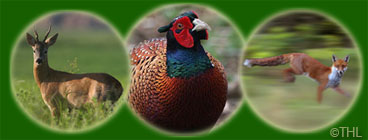Rabbit
The rabbit is a social kind of a creature and can be found throughout the length and breath of our country. Practically every hunter I know cut their teeth on this gregarious rodent and we have much to thank them for. Some pest controllers need to cull rabbits all year round to prevent crop damage, but the rest of us usually start our rabbiting sometime around august/September.
Practically every hunter I know cut their teeth on this gregarious rodent and we have much to thank them for. Some pest controllers need to cull rabbits all year round to prevent crop damage, but the rest of us usually start our rabbiting sometime around august/September.
Many methods can be utilised in the control of this fast-multiplying rodent, the most popular being ferreting, and hunting during the daytime with a lurcher and lamping at night. There are, of course, other, more complex, methods such as long netting, snaring and trapping, but as this is just a basic guide we will not elaborate on them for now.
It is a very well known fact that rabbits often spend their daytime down below ground in a network of tight tubes, each one linking with the next, forming an underground maze. If we are to catch rabbits living in this manor then we must enlist the help of a ferret. This domesticated polecat is the rabbits worst nightmare and being long, lean and fast, they can rattle through the tubes forcing the startled rabbit to bolt for another place to escape the ferrets murderous intentions. This is the reason why we place nets on the holes, to catch the bunny as it tries to escape. Well, that is the plan, but sometimes the wriggly critters escape, as the net doesn’t quite catch them right. These nets are called “purse nets” and are available in lengths from 3 foot to 5 foot. The length you use will be entirely dependant on your local ferreting conditions. We would advise that the beginner purchases several different lengths to see which suits his own ferreting needs. Ferreting is a great way of starting out and we have had some of our best times when accompanied by our mustalid friends.
Now lets look at catching rabbits during daytime with the aid of a lurcher.
What greater sight is there than watching a good dog hunting up. The lurcher winds its prey where it lays hidden in the long grass. Closer and closer he gets using the wind to work out the location and distance of his prey. A strike, a squeal and it’s all over. Some rabbits are in their holes during the daytime but many will also be laid out in the fields amongst rough grass where they feel safe and hidden from predators. A good lurcher will be able to use his nose to locate the rabbits though, even if they are well tucked away. Your dog will get better and better at finding rabbits and before you know it the dog will be hunting like an old hound. Sure, a novice dog may struggle a little at first but the more experience the dog gets the heavier your game bag will be. This is a method for those that like watching dogs work. You will never need to hire a skip to bring home all your catch, but don’t forget that the enjoyment factor is the most important criteria when out in the field.
So what of this mysterious lamping game? To start with there’s nothing remotely mysterious about it. It boils down to hunting rabbits at night with a lamp and letting the dog chase them. And that’s it! Any size of dog, any breed of dog is capable of catching on the lamp. As long as the dog is fast enough to actually gain on the rabbit it should be ok. We try to shine from the rabbit’s sanctuary. This is usually a hedgerow or a wood. Once there we have a sweep of the field with the lamp. There’s no rush, just take your time and look for that ruby glint signifying a rabbit under the spotlight. All you need to do is slip your dog and catch the rabbit. Of course, it never is as simple as that and there will be many frustrations along the way to becoming proficient at this activity, but that’s all part of the learning experience. Lamping is brilliant and we have had some very good hauls of game with the lurcher and lamp. Give it a go. You wont be disappointed.
We could go much further into detail regarding these methods, but the above is just written to give an insight, a mere glimpse, of the basics of catching rabbits.

